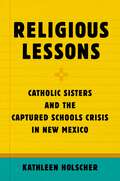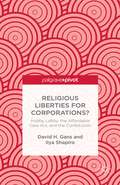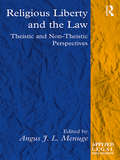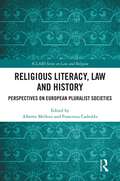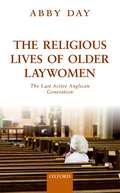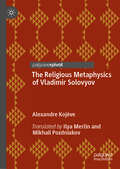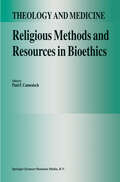- Table View
- List View
Religious Lessons: Catholic Sisters and the Captured Schools Crisis in New Mexico
by Kathleen HolscherReligious Lessons tells the story of Zellers v. Huff, a court case that challenged the employment of nearly 150 Catholic sisters in public schools across New Mexico in 1948. Known nationally as the "Dixon case," after one of the towns involved, it was the most famous in a series of midcentury lawsuits, all targeting what opponents provocatively dubbed "captive schools." Spearheaded by Protestants and Other Americans United for Separation of Church and State, the publicity campaign built around Zellers drew on centuries-old rhetoric of Catholic captivity to remind Americans about the threat of Catholic power in the post-War era, and the danger Catholic sisters dressed in full habits posed to American education. Americans at midcentury were reckoning with the U.S. Supreme Court's new mandate for a "wall of separation" between church and state. At no time since the nation's founding was the Establishment Clause studied so carefully by the nation's judiciary and its people. While Zellers never reached the Supreme Court, its details were familiar to hundreds of thousands of citizens who read about them in magazines and heard them discussed in church on Sunday mornings. For many Americans, Catholic and not, the scenario of sisters in veils teaching children embodied the high stakes of the era's church-state conflicts, and became an occasion to assess the implications of separation in their lives. Through close study of the Dixon case, Kathleen Holscher brings together the perspectives of legal advocacy groups, Catholic sisters, and citizens who cared about their schools. She argues that the captive school crusade was a transitional episode in the Protestant-Catholic conflicts that dominate American church-state history. Religious Lessons also goes beyond legal discourse to consider the interests of Americans--women religious included--who did not formally articulate convictions about the separation principle. The book emphasizes the everyday experiences, inside and outside classrooms, that defined the church-state relationship for these people, and that made these constitutional questions relevant to them.
Religious Liberties: Anti-Catholicism and Liberal Democracy in Nineteenth-Century U.S. Literature and Culture (Imagining the Americas)
by Elizabeth FentonIn the late eighteenth and nineteenth centuries, Catholicism was often presented in the U.S. not only as a threat to Protestantism but also as an enemy of democracy. Focusing on literary and cultural representations of Catholics as a political force, Elizabeth Fenton argues that the U.S. perception of religious freedom grew partly, and paradoxically, out of a sometimes virulent but often genteel anti-Catholicism. Depictions of Catholicism's imagined intolerance and cruelty allowed writers time and again to depict their nation as tolerant and free. As Religious Liberties shows, anti-Catholic sentiment particularly shaped U.S. conceptions of pluralism and its relationship to issues as diverse as religious privacy, territorial expansion, female citizenship, political representation, chattel slavery, and governmental partisanship. Drawing on a wide range of materials--from the Federalist Papers to antebellum biographies of Toussaint Louverture; from nativist treatises to Margaret Fuller's journalism; from convent exposés to novels by Catharine Sedgwick, Augusta J. Evans, Nathanial Hawthorne, Harriet Beecher Stowe, Herman Melville, and Mark Twain--Fenton's study excavates the influence of anti-Catholic sentiment on both the liberal tradition and early U.S. culture more generally. In concert, these texts suggest how the prejudice against Catholicism facilitated an alignment of U.S. nationalism with Protestantism, thus ensuring the mutual dependence, rather than the putative "separation" of church and state.
Religious Liberties for Corporations?: Hobby Lobby, the Affordable Care Act, and the Constitution
by I. Shapiro D. Gans Ralf NorrmanAn expanded version of a series of debates between the authors, this book examines the nature of corporate rights, especially with respect to religious liberty, in the context of the controversial Hobby Lobby case from the Supreme Court's 2013-14 term.
Religious Liberty and the Law: Theistic and Non-Theistic Perspectives (Applied Legal Philosophy)
by Angus J. L. MenugeQuestions of religious liberty have become flashpoints of controversy in virtually every area of life around the world. Despite the protection of religious liberty at both national and supranational levels, there is an increasing number of conflicts concerning the proper way to recognize it – both in modern secular states and in countries with an established religion or theocratic mode of government. This book provides an analysis of the general concept of religious liberty along with a close study of important cases that can serve as test beds for conflict resolution proposals. It combines the insights of both pure academics and experienced legal practitioners to take a fresh look at the nature, scope and limits of religious liberty. Divided into two parts, the collection presents a blend of legal and philosophical approaches, and draws on cases from a wide range of jurisdictions, including Brazil, India, Australia, the USA, the Netherlands, and Canada. Presenting a broad range of views, this often provocative volume makes for fascinating reading for academics and researchers working in the areas of law and religion, legal philosophy and human rights.
Religious Liberty and the Law: Theistic and Non-Theistic Perspectives (Applied Legal Philosophy)
by Menuge Angus J. L.Questions of religious liberty have become flashpoints of controversy in virtually every area of life around the world. Despite the protection of religious liberty at both national and supranational levels, there is an increasing number of conflicts concerning the proper way to recognize it – both in modern secular states and in countries with an established religion or theocratic mode of government. This book provides an analysis of the general concept of religious liberty along with a close study of important cases that can serve as test beds for conflict resolution proposals. It combines the insights of both pure academics and experienced legal practitioners to take a fresh look at the nature, scope and limits of religious liberty. Divided into two parts, the collection presents a blend of legal and philosophical approaches, and draws on cases from a wide range of jurisdictions, including Brazil, India, Australia, the USA, the Netherlands, and Canada. Presenting a broad range of views, this often provocative volume makes for fascinating reading for academics and researchers working in the areas of law and religion, legal philosophy and human rights.
Religious Liberty in a Lockean Society (Palgrave Studies in Religion, Politics, and Policy)
by Elissa B. AlzateThis book assesses the concept of religious liberty in the United States according to the political theory of John Locke. Protecting the individual freedom of religion without infringing on the rights of others or on legitimate political authority requires delicate balance. The work analyzes Locke’s concept of religious liberty and, from it, derives nine criteria for locating that balance. The most important of these criteria requires government neutrality and equality before the law. The United States has historically struggled with providing this balance, particularly through Supreme Court decisions, resulting in the passage of the Religious Freedom Restoration Act (RFRA). Application of Locke’s criteria for balancing religious liberty and government authority to three recent cases—a government employee, an employer, and a small business owner—reveal that RFRA legislation threatens this balance by undermining neutral government action and treats citizens unequally before the law.
Religious Life and English Culture in the Reformation
by M. KaartinenMarjo Kaartinen has brought the world of monks, friars, and nuns freshly alive in the late fifteenth and early sixteenth century. Their monastic vows - obedience, poverty, chastity, and stability - still made a difference to them and to the laypeople around them, even when they failed to live up to them. Much of Kaartinen's story is told through the words of the religious themselves, from self-defence to self-criticism, and this makes the reading all the better. Religious Life and English Culture in the Reformation helps us understand why some forms of Catholic sensibility lasted so long and why Protestant reformers drew from the very ideals they wanted to undermine.
Religious Life in Late Classical and Hellenistic Rhodes (Oxford Classical Monographs)
by Juliane ZachhuberThe ancient state of Rhodes was famous for many things in the Hellenistic period; it emerged as an economic powerhouse thanks to its strategic position on maritime trade routes, its status further bolstered by its proud independence in an era of great kings, and its cultural successes and heritage celebrated by contemporaries as well as later writers. But what did this state look like on the inside, and what social and religious forces contributed to its success? This book explores the origins of the Rhodian state in the late fifth century BC, a union born out of three separate city-states, Lindos, Cameiros, and Ialysos. By digging deep into the abundant epigraphic culture that survives, narratives emerge that tell the stories of these Rhodians and their communities. Despite the political unification and the foundation of a famed and successful capital city, Rhodes-town, the three old centres continued to exhibit distinctive and seemingly lively local religious cultures. What these looked like, and the question of whether they indicate cultic vitality rather than ossification, is considered in detail by examining the local pantheons and the religious dynamics and interactions that characterised and shaped them. Pulling together the diverse threads and local customs, a diachronic religious history of Rhodes is sketched. The role religion played in the social landscape of Hellenistic Rhodes is addressed through a thorough examination of priesthoods. Finally, providing a counterbalance to the institutional side of religion, the lived experience of Rhodian religious associations is depicted. The resulting picture offers a nuanced insight into the religious life and history of a Hellenistic city-state.
Religious Life in Late Classical and Hellenistic Rhodes (Oxford Classical Monographs)
by Juliane ZachhuberThe ancient state of Rhodes was famous for many things in the Hellenistic period; it emerged as an economic powerhouse thanks to its strategic position on maritime trade routes, its status further bolstered by its proud independence in an era of great kings, and its cultural successes and heritage celebrated by contemporaries as well as later writers. But what did this state look like on the inside, and what social and religious forces contributed to its success? This book explores the origins of the Rhodian state in the late fifth century BC, a union born out of three separate city-states, Lindos, Cameiros, and Ialysos. By digging deep into the abundant epigraphic culture that survives, narratives emerge that tell the stories of these Rhodians and their communities. Despite the political unification and the foundation of a famed and successful capital city, Rhodes-town, the three old centres continued to exhibit distinctive and seemingly lively local religious cultures. What these looked like, and the question of whether they indicate cultic vitality rather than ossification, is considered in detail by examining the local pantheons and the religious dynamics and interactions that characterised and shaped them. Pulling together the diverse threads and local customs, a diachronic religious history of Rhodes is sketched. The role religion played in the social landscape of Hellenistic Rhodes is addressed through a thorough examination of priesthoods. Finally, providing a counterbalance to the institutional side of religion, the lived experience of Rhodian religious associations is depicted. The resulting picture offers a nuanced insight into the religious life and history of a Hellenistic city-state.
The Religious Life of Dress: Global Fashion and Faith (Dress, Body, Culture)
by Lynne HumeFrom clothing to the painted and scarified nude body, through overt, public display or esoteric symbols known only to the initiated, dress can convey information about beliefs, faith, identity, power, agency, resistance, and fashion. Taking a 'senses' approach, Hume's engaging account takes into consideration the look, smell, feel, touch and sound of religious apparel, the 'smells and bells' of dress and its accoutrements, as well as the emotions evoked by donning religious garb. The book's global perspective provides wide-ranging, yet detailed, coverage of religious dress, from the history and meaning of the simple 'no-frills' attire of the Anabaptists to the power structure displayed in the elaborate fabrics and colours of the Roman Catholic Church; Hume examines the 2,500 year-old tradition of Buddhist robes, the nudity of India's holy men, and much more. With chapters on Sufism, Vodou, modern Pagans, as well as painted and tattooed indigenous and modern Western bodies, the reader is swept along on a sensual journey of the sight, sound, smell and feel of wearing religion. Unique in its field, this intriguing and informative anthropological approach to the body and dress is an essential read for students of Anthropology, Anthropology of Dress, Sociology, Fashion and Textiles, Culture and Dress, Body and Culture and Cultural Studies.
The Religious Life of Dress: Global Fashion and Faith (Dress, Body, Culture)
by Lynne HumeFrom clothing to the painted and scarified nude body, through overt, public display or esoteric symbols known only to the initiated, dress can convey information about beliefs, faith, identity, power, agency, resistance, and fashion. Taking a 'senses' approach, Hume's engaging account takes into consideration the look, smell, feel, touch and sound of religious apparel, the 'smells and bells' of dress and its accoutrements, as well as the emotions evoked by donning religious garb. The book's global perspective provides wide-ranging, yet detailed, coverage of religious dress, from the history and meaning of the simple 'no-frills' attire of the Anabaptists to the power structure displayed in the elaborate fabrics and colours of the Roman Catholic Church; Hume examines the 2,500 year-old tradition of Buddhist robes, the nudity of India's holy men, and much more. With chapters on Sufism, Vodou, modern Pagans, as well as painted and tattooed indigenous and modern Western bodies, the reader is swept along on a sensual journey of the sight, sound, smell and feel of wearing religion. Unique in its field, this intriguing and informative anthropological approach to the body and dress is an essential read for students of Anthropology, Anthropology of Dress, Sociology, Fashion and Textiles, Culture and Dress, Body and Culture and Cultural Studies.
Religious Literacy in Hospice Care: Challenges and Controversies
by Panagiotis PentarisThis is the first book to explore how religion, belief and spirituality are negotiated in hospice care. Specifically, it considers the significant place that spiritual care has in hospice care and claims that the changing role of religion and belief in society highlights the need to re-examine how such identities are integrated in professional practice. Using religious literacy as a framework, the author explores how healthcare professionals in hospice care respond to religion, belief and spiritual identities of service users. Part 1 provides a comprehensive account of the content and history of the place of religion, belief and spirituality in hospice care. Part 2 examines how these topics are negotiated in hospice care by looking at three key areas: environment, professional practice and organisation. Part 3 proposes a religious literacy model applicable to hospice care and explores implications for practice and policy. Lastly, the author identifies future trends in research, policy and practice. Drawing on a range of theories and concepts and proposing a working model that can impact the training of future and current professionals, Religious Literary in Hospice Care should be considered essential reading for students, researchers and practitioners.
Religious Literacy in Hospice Care: Challenges and Controversies
by Panagiotis PentarisThis is the first book to explore how religion, belief and spirituality are negotiated in hospice care. Specifically, it considers the significant place that spiritual care has in hospice care and claims that the changing role of religion and belief in society highlights the need to re-examine how such identities are integrated in professional practice. Using religious literacy as a framework, the author explores how healthcare professionals in hospice care respond to religion, belief and spiritual identities of service users. Part 1 provides a comprehensive account of the content and history of the place of religion, belief and spirituality in hospice care. Part 2 examines how these topics are negotiated in hospice care by looking at three key areas: environment, professional practice and organisation. Part 3 proposes a religious literacy model applicable to hospice care and explores implications for practice and policy. Lastly, the author identifies future trends in research, policy and practice. Drawing on a range of theories and concepts and proposing a working model that can impact the training of future and current professionals, Religious Literary in Hospice Care should be considered essential reading for students, researchers and practitioners.
Religious literacy in policy and practice
by Adam Dinham Matthew FrancisIt has long been assumed that religion is in decline in the West: however it continues to have an important yet contested role in individual lives and in society at large. Furthermore half a century or so in which religion and belief were barely talked about in public has resulted in a pressing lack of religious literacy, leaving many ill-equipped to engage with religion and belief when they encounter them in daily life – in relationships, law, media, the professions, business and politics, among others. This valuable book is the first to bring together theory and policy with analysis and expertise on practices in key areas of the public realm to explore what religious literacy is, why it is needed and what might be done about it. It makes the case for a public realm which is well equipped to engage with the plurality and pervasiveness of religion and belief, whatever the individual’s own stance. It is aimed at academics, policy-makers and practitioners interested in the policy and practice implications of the continuing presence of religion and belief in the public sphere.
Religious literacy in policy and practice
by Adam Dinham Matthew FrancisIt has long been assumed that religion is in decline in the West: however it continues to have an important yet contested role in individual lives and in society at large. Furthermore half a century or so in which religion and belief were barely talked about in public has resulted in a pressing lack of religious literacy, leaving many ill-equipped to engage with religion and belief when they encounter them in daily life – in relationships, law, media, the professions, business and politics, among others. This valuable book is the first to bring together theory and policy with analysis and expertise on practices in key areas of the public realm to explore what religious literacy is, why it is needed and what might be done about it. It makes the case for a public realm which is well equipped to engage with the plurality and pervasiveness of religion and belief, whatever the individual’s own stance. It is aimed at academics, policy-makers and practitioners interested in the policy and practice implications of the continuing presence of religion and belief in the public sphere.
Religious Literacy, Law and History: Perspectives on European Pluralist Societies (ICLARS Series on Law and Religion)
by Alberto Melloni Francesca CadedduThe book profiles some of the macro and micro factors that have impact on European religious literacy. It seeks to understand religious illiteracy and its effects on the social and political milieu through the framing of the historical, institutional, religious, social, juridical and educational conditions within which it arises. Divided into four parts, in the first one, One literacy, more literacies?, the book defines the basic concepts underpinning the question of religious illiteracy in Europe. Part II, Understanding illiteracies, debating disciplines?, highlights the theological, philosophical, historical and political roots of the phenomenon, looking at the main nodes that are both the reasons religious illiteracy is widespread and the starting points for literacy strategies. Part III, Building literacy, shaping alphabets, examines the mix of knowledge and competences acquired about religion and from religion at school as well as through the media, with a critical perspective on what could be done both in the schools and for the improvement of journalists’ religious literacy. Part IV, Views and experiences, presents the reader with the opportunity to learn from three different case studies: religious literacy in the media, religious illiteracy and European Islam, and a Jewish approach to religious literacy. Building on existing literature, the volume takes a scientific approach which is enriched by interdisciplinary and transnational perspectives, and deep entrenchment in historical methodology.
Religious Literacy, Law and History: Perspectives on European Pluralist Societies (ICLARS Series on Law and Religion)
by Alberto Melloni Francesca CadedduThe book profiles some of the macro and micro factors that have impact on European religious literacy. It seeks to understand religious illiteracy and its effects on the social and political milieu through the framing of the historical, institutional, religious, social, juridical and educational conditions within which it arises. Divided into four parts, in the first one, One literacy, more literacies?, the book defines the basic concepts underpinning the question of religious illiteracy in Europe. Part II, Understanding illiteracies, debating disciplines?, highlights the theological, philosophical, historical and political roots of the phenomenon, looking at the main nodes that are both the reasons religious illiteracy is widespread and the starting points for literacy strategies. Part III, Building literacy, shaping alphabets, examines the mix of knowledge and competences acquired about religion and from religion at school as well as through the media, with a critical perspective on what could be done both in the schools and for the improvement of journalists’ religious literacy. Part IV, Views and experiences, presents the reader with the opportunity to learn from three different case studies: religious literacy in the media, religious illiteracy and European Islam, and a Jewish approach to religious literacy. Building on existing literature, the volume takes a scientific approach which is enriched by interdisciplinary and transnational perspectives, and deep entrenchment in historical methodology.
The Religious Lives of Older Laywomen: The Last Active Anglican Generation
by Dr Abby DayThe Religious Lives of Older Laywomen draws on ethnographic fieldwork, cross-cultural comparisons, and relevant theories exploring the beliefs, identities, and practices of 'Generation A'—Anglican laywomen born in the 1920s and 1930s. Now in their 70s, 80s, and 90s, they are often described as the 'backbone' of the Church and likely its final active generation. The prevalence of laywomen in mainstream Christian congregations is a widely accepted phenomenon that will cause little surprise amongst the research community or Christian adherents. What is surprising is that we know so little about them. Generation A laywomen have remained largely invisible in previous work on institutional religion in Euro-American countries, particularly as the focus on religion and gender has turned to youth, sexuality, and priesthood. Female Christian Generation A is on the cusp of a catastrophic decline in mainstream Christianity that accelerated during the 'post-war' (post-1945) age. The age profile of mainstream Christianity represents an increasingly aging pattern, with Generation A not being replaced by their children or grandchildren—the Baby-Boomers and generations X, Y, and Z. Generation A is irreplaceable and unique. 'Generation' shares specific values, beliefs, behaviours, and orientations, therefore, when this generation finally disappears within the next five to 10 years, their knowledge, insights, and experiences will be lost forever. Abby Day both documents and interprets their religious lives and what we can learn about them and more widely, about contemporary Christianity and its future.
The Religious Lives of Older Laywomen: The Last Active Anglican Generation
by Dr Abby DayThe Religious Lives of Older Laywomen draws on ethnographic fieldwork, cross-cultural comparisons, and relevant theories exploring the beliefs, identities, and practices of 'Generation A'—Anglican laywomen born in the 1920s and 1930s. Now in their 70s, 80s, and 90s, they are often described as the 'backbone' of the Church and likely its final active generation. The prevalence of laywomen in mainstream Christian congregations is a widely accepted phenomenon that will cause little surprise amongst the research community or Christian adherents. What is surprising is that we know so little about them. Generation A laywomen have remained largely invisible in previous work on institutional religion in Euro-American countries, particularly as the focus on religion and gender has turned to youth, sexuality, and priesthood. Female Christian Generation A is on the cusp of a catastrophic decline in mainstream Christianity that accelerated during the 'post-war' (post-1945) age. The age profile of mainstream Christianity represents an increasingly aging pattern, with Generation A not being replaced by their children or grandchildren—the Baby-Boomers and generations X, Y, and Z. Generation A is irreplaceable and unique. 'Generation' shares specific values, beliefs, behaviours, and orientations, therefore, when this generation finally disappears within the next five to 10 years, their knowledge, insights, and experiences will be lost forever. Abby Day both documents and interprets their religious lives and what we can learn about them and more widely, about contemporary Christianity and its future.
Religious Melancholy And Protestant Experience In America
by Julius H. RubinThis original examination of the spiritual narratives of conversion in the history of American Protestant evangelical religion reveals an interesting paradox. Fervent believers who devoted themselves completely to the challenges of making a Christian life, who longed to know God's rapturous love, all too often languished in despair, feeling forsaken by God. Ironically, those most devoted to fostering the soul's maturation neglected the well-being of the psyche. Drawing upon many sources, including unpublished diaries and case studies of patients treated in nineteenth-century asylums, Julius Rubin's fascinating study thoroughly explores religious melancholy--as a distinctive stance toward life, a grieving over the loss of God's love, and an obsession and psychopathology associated with the spiritual itinerary of conversion. The varieties of this spiritual sickness include sinners who would fast unto death ("evangelical anorexia nervosa"), religious suicides, and those obsessed with unpardonable sin. From colonial Puritans like Michael Wigglesworth to contemporary evangelicals like Billy Graham, among those who directed the course of evangelical religion and of their followers, Rubin shows that religious melancholy has shaped the experience of self and identity for those who sought rebirth as children of God.
Religious Melancholy and Protestant Experience in America (Religion in America)
by Julius H. RubinThis original examination of the spiritual narratives of conversion in the history of American Protestant evangelical religion reveals an interesting paradox. Fervent believers who devoted themselves completely to the challenges of making a Christian life, who longed to know God's rapturous love, all too often languished in despair, feeling forsaken by God. Ironically, those most devoted to fostering the soul's maturation neglected the well-being of the psyche. Drawing upon many sources, including unpublished diaries and case studies of patients treated in nineteenth-century asylums, Julius Rubin's fascinating study thoroughly explores religious melancholy--as a distinctive stance toward life, a grieving over the loss of God's love, and an obsession and psychopathology associated with the spiritual itinerary of conversion. The varieties of this spiritual sickness include sinners who would fast unto death ("evangelical anorexia nervosa"), religious suicides, and those obsessed with unpardonable sin. From colonial Puritans like Michael Wigglesworth to contemporary evangelicals like Billy Graham, among those who directed the course of evangelical religion and of their followers, Rubin shows that religious melancholy has shaped the experience of self and identity for those who sought rebirth as children of God.
The Religious Metaphysics of Vladimir Solovyov
by Alexandre KojèveThe original text of this work was published in the French journal Revue d’Histoire et de Philosophie Religieuses. This English translation presents Kojève’s attempt to unify the religious philosophy of Vladimir Solovyov into a metaphysical system that Solovyov strived for but was never able to fully articulate in his lifetime.
Religious Methods and Resources in Bioethics (Theology and Medicine #2)
by P. F. CamenischA volume on religious/theological methods in biomedical ethics inevitably of whether the methodological dimension can be distin raises the question guished from the various other things that go on in ethical discourse. It is difficult to answer this question definitively since many elements in moral conversation can be interpreted in different ways. Barbara Hilkert Andolsen illustrates this issue in this volume when she defines one of her crucial cate gories, gender justice, as being both procedural and substantive/normative. This difficulty of finally separating the methodological from the normative arises in many areas of contemporary ethical writing, both feminist and otherwise. Nevertheless, it seems that in many cases we can separate out the method ological issues with considerable precision. Albert Jonsen and James Childress achieve just such a sharp focus in their essays. This does not mean that a careful dissecting of their papers would not reveal normative elements lurking about their methodological points. It is simply to say that the issues they analyze and the positions they take are, at least prima facie, overwhelmingly method ological. They are much more about how we think about ethical matters than they are about what we think about them.
Religious Minorities in Iraq: Co-Existence, Faith and Recovery after ISIS
by Maria Rita CorticelliThe religious minorities of Iraq suffered immense violence at the hands of ISIS and they are now trying to rebuild their lives. In their own words, this book tells their stories of resilience against oppression, creativity in the darkest moments, and hope amidst death. Covering the experiences of the Christians, Kakais, Yezidis, Sunni Muslims and Shabaks, among others, this is an in-depth investigation that reveals how the different communities narrate their beliefs and deal with life and recovery in the aftermath of ISIS.Existing literature on the religious minorities in Iraq treats them in isolation as if they do not interact. This is the first book to show that a strong network between them operates in the absence of a strong civil society and based on a common desire to coexist, reconstruct their society and build peace. Over three years, the author visited religious and archaeological sites and interviewed more than one hundred people between representatives of the religious communities, academics, activists, politicians, policy makers and refugees. Among them are victims and persecutors, men, women and children, all who have been overwhelmed by the tragic events of the last few years. The author shows that all these groups are animated by the same desire for a new, more tolerant society and that their treatment of each other is nurtured by their shared experience of persecution and oppression.
Religious Minorities in Iraq: Co-Existence, Faith and Recovery after ISIS
by Maria Rita CorticelliThe religious minorities of Iraq suffered immense violence at the hands of ISIS and they are now trying to rebuild their lives. In their own words, this book tells their stories of resilience against oppression, creativity in the darkest moments, and hope amidst death. Covering the experiences of the Christians, Kakais, Yezidis, Sunni Muslims and Shabaks, among others, this is an in-depth investigation that reveals how the different communities narrate their beliefs and deal with life and recovery in the aftermath of ISIS.Existing literature on the religious minorities in Iraq treats them in isolation as if they do not interact. This is the first book to show that a strong network between them operates in the absence of a strong civil society and based on a common desire to coexist, reconstruct their society and build peace. Over three years, the author visited religious and archaeological sites and interviewed more than one hundred people between representatives of the religious communities, academics, activists, politicians, policy makers and refugees. Among them are victims and persecutors, men, women and children, all who have been overwhelmed by the tragic events of the last few years. The author shows that all these groups are animated by the same desire for a new, more tolerant society and that their treatment of each other is nurtured by their shared experience of persecution and oppression.
